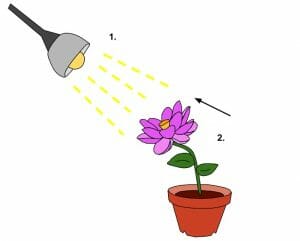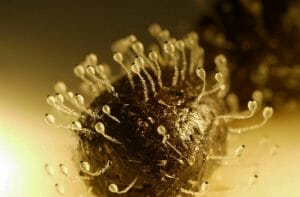Phototropism Definition
Phototropism is the ability of a plant, or other photosynthesizing organism, to grow directionally in response to a light source.

Plants and other autotrophs need to manufacture their own food; they usually do this through photosynthesis. Through photosynthesis, organisms convert water, carbon dioxide (CO2) and light into sugars, which are used for energy and growth.
Plants are sessile, meaning they cannot move around to acquire what they need, so in order to maximize the amount of light that they receive through the leaves, they use phototropism.
Positive phototropism is the response of a plant toward a light source, while negative phototropism (also called “aphototropism”) causes growth in the opposite direction. Plant roots usually use negative phototropism although additionally they use “gravitropism”, which is the response to gravitational pull.
How Does Phototropism Work?
The plants first sense the light using photoreceptors. Photoreceptors are special molecules consisting of a protein and a pigment that absorbs light called a chromophore. When light is absorbed by the chromophore, the protein changes shape, initiating a signaling pathway. Plants use signaling pathways to initiate processes such as gene expression, hormone production and growth. The specific photoreceptors which are responsible for detecting light during phototropism are called phototropins.
In 1880, Charles Darwin and his son Frances, discovered that seedlings with the very tip of a sheath called the coleoptile covered did not respond to light, whereas those with the lower part of the coleoptile covered did. From this they theorized that the light-sensing activity took place within the tips of the plant.
Plants contain a hormone called auxin, which coordinates many growth and behavioral processes throughout their life cycles. It is this auxin, which is responsible for the curvature of the stems, allowing plants to grow in a certain direction.
When the phototropins are activated by a light source, auxins are redistributed up the coleoptile and toward the side of the stem where the phototropins are less active – the shaded side.
The auxin activates proton pumps, which lowers the pH of the cells, making them more acidic. This acidification activates enzymes called expansins, which cause the cell walls to become more flexible by breaking the hydrogen bonds. When cell walls are less rigid, the cell walls are able to grow larger and faster than usual.
The larger size of the cells on the shaded size causes an asymmetry of cell size within the stem, and thus, the stem bends toward the light.

Examples of Phototropism
Sunflowers
An example of a plant that is highly phototrophic is the sunflower (Helianthus annus).
Not only do sunflowers grow toward the sun, they can be visibly seen to track the sun’s movements from East to West throughout the day. At night, the heads move back from West to East in anticipation of the next day’s sunrise.
Scientists have discovered that sunflowers need more light for growth and survival, as well as fruiting, and flowering, than most other flowering plants. This finding is a likely reason for the daily solar tracking activity.
Pilobolus Fungi
Fungi in the genus Pilobolus are saprobic feeders, meaning they feed from non-living or decaying organic material.
In the case of the species Pilobolus crystallinus (commonly known as the “hat-thrower fungus”), they survive by eating the feces of grazing herbivores.
In order to gain access to feces, P.crystallinus uses an explosive propulsion technique, whereby the spores are shot from the sporangiophore in to the air and attach to vegetation. When grazing animals eat the vegetation, the spores pass through the animal’s digestive system and end up in their feces.
P.crystallinus uses phototropism so that their spores will be directed toward a light space where there is likely to be a gap in the grass, so they have a better chance of dispersal. Animals do not usually eat near dung, so they need to disperse their spores away from the dung on which their mycelium grew to increase their chances of being consumed.

The image shows Pilobolus crystallinus growing on a piece of dung. The sporangiophores are all pointing in a single direction, determined by the source of light.
Related Biology Terms
- Photosynthesis – The process by which photosynthesizing organisms convert light energy, carbon dioxide and water into oxygen and organic compounds.
- Skototropism – The growth of organisms away from a light source, often utilized by root climbers in order to find structures to attach to.
- Photoperiodism – The mechanism by which organisms respond to seasonal changes in day length.
Quiz
1. How does auxin cause plant stems to bend toward light?
A. Increases the surface area of cells on the side facing the light source
B. Activates expansins, which break down cell walls and causes them to grow
C. Shrinks the cells on the side facing the light source
D. Activates phototropins, which move toward the light
2. Which part of the plant does phototropism take place?
A. The tips of stems
B. The middle of stems
C. The base of stems
D. The roots
3. Why do Pilobolus fungi use phototropism?
A. They need to grow toward light to photosynthesize
B. To grow taller, faster and maximize their chance of being eaten
C. To grow toward light so they can disperse their spores in the right direction
D. Because they need more energy than other fungi
